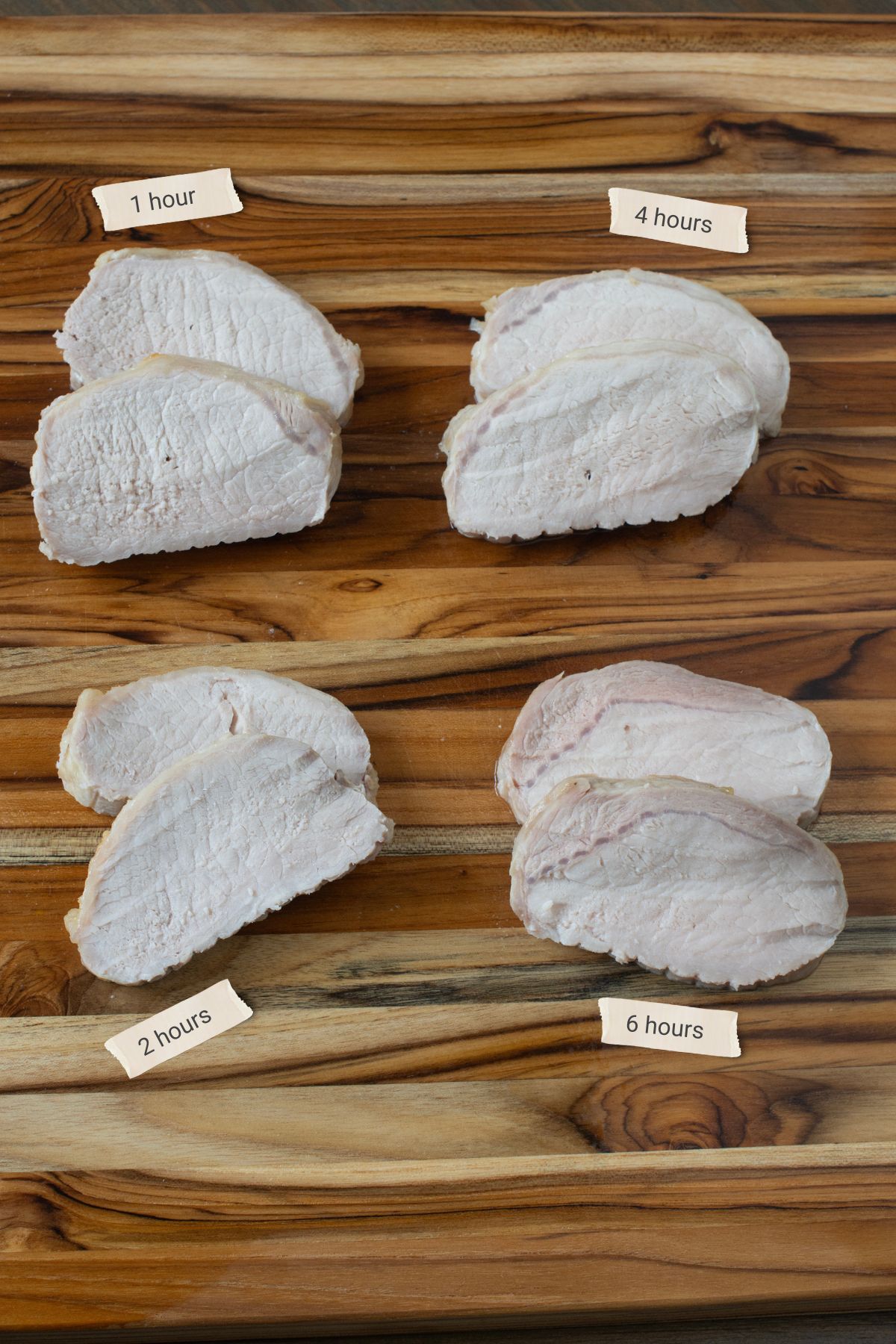I’ve done the testing to get perfect timing! Learn how to brine pork loin like an expert, so that you always have tender and moist pork.
I’ve done lots of testing to perfect the best method and timing for brining a variety of meats. Now it’s time to share how to brine pork loin for well seasoned, juicy pork every time. Get all my test results and recommendations and get ready to cook some delicious pork!
Scroll down to read more about how it all comes together or click here to jump straight down to the recipe.

What Does Brining Do?
Brining means soaking your meat in a salt water solution before cooking it. Using a brine changes meat in three ways.
- Meats soak up salt water more easily than plain water. So you’re adding moisture to the meat, which, once it’s cooked, makes the meat itself seem moister.
- The salt changes the texture of the meat. It’s a type of denaturing. So, meat that is brined also has a more tender texture.
- Finally, because we’re working with salt and because that salt is dissolved in water and then getting right into the meat, when you brine something, you are essentially seasoning it on the inside making it taste extra delicious.
All of that is going on and the result is meat (pork loin, in this case) that is juicier, more tender, and more flavorful. I think that’s definitely worth the time!
Now there is another way that you can brine pork and other cuts of meat. It’s called a dry brine and doesn’t use water. Instead, you sprinkle the meat with salt and leave it uncovered in the fridge. It’s actually a very convenient technique to learn, but is not what we’re talking about here today.
Note that dry brining is especially useful for large pieces of meat, like turkey, since you don’t need to find a large container to hold them and the water. Learn how to dry brine a turkey here.
What Goes In A Brine?
All that is needed for a brine is salt and water. Sometimes additional seasonings or sugar are added as well. I used my standard brine recipe for testing, if you are brining two pork loins, you will likely need to double the recipe to cover the pork. It depends on the size of the container you’re using and the amount of meat you’re brining.
My standard brine recipe is essentially: 4 cups of cold water and 6 tablespoons Diamond Crystal kosher salt OR 4 1/2 tablespoons Morton’s kosher salt OR 3 tablespoons fine or table salt.
It does actually matter what kind of salt you have and how much you use. The salt crystals in these types are all of different sizes and if you use the incorrect type or incorrect amount, you will end up with a brine that is either way too salty or not salty enough.
How To Make The Brine
To make the brine, all you need to do is mix together the salt and the water. It’s a large amount of salt though so it can take a minute or two for it to dissolve. It will though. Just stir it together and keep stirring until it’s less cloudy and there’s no more salt undissolved at the bottom.
There’s no need to use warm water, in my testing I’ve found that cold water is the better option.

Some people like to add optional ingredients for flavor such as black peppercorns, crushed garlic, onion slices, fresh rosemary or thyme, bay leaves, or other herbs and spices. Like with our previous brine experiments, I didn’t feel that the flavors of additional elements came through.
If you want to add anything to the standard pork loin brine, stick with some garlic powder or onion powder. If you want to add more extra flavor, go with the slurry that I make in the food processor for my best turkey brine recipe. It’s full of onion, garlic, and fresh herbs, combined in a way that really gets the flavors into the meat.
How Long Should I Brine Pork Loin?
For my testing with brining pork loin, I tried four different brining times and have given you all the results below. This method is what I used for my chicken breast brining as well as my pork chop brine, so make sure to take a look at those results too. I’ve also tested to get perfectly brined pork tenderloin.

Not all pork loins are created equal. As you can see, some are thicker and some are longer. To control for that, I did the comparisons more than one time, and I tried to compare roasts that were similar to each other, always cooking everything to 145°F and then letting it rise to 150°F before slicing.
We tasted from the ends and from the middle, comparing end slices to end slices and middle slices to middle slices. The results were the same no matter what shape the roast was though.

Chart: Pork Loin Flavor and Texture Changes After Brining
| BRINING TIME | RESULTS |
| 1 hour | The texture is drier and similar to un-brined cooked pork, no real effect from brining other than some slight seasoning on the outside. |
| 2 hours | The texture is still pretty much unchanged, but has more of a nice seasoning going on and slightly juicier in taste than the 1 hour test. |
| 4 hours | You can see that the texture has changed and is less dry-looking. Nicely salted throughout, much juicier. Some people might find this a tad too salty and if you’re sensitive to salt, I’d say do 3 hours. |
| 6 hours | This had the biggest texture change, almost like processed pork meat (pork lunchmeat) but way too salty. |
My recommendation for the best pork loin results is to brine for 3 – 4 hours which will give you juicy meat with good seasoning from the salt.
How To Cook Pork Loin After Brining
For just basic baked pork loin (nothing fancy) you’ll bake it at 300°F until it reaches 145°F in the center, about 18 minutes per pound. Check the temperature after about 45 minutes since some of them are thinner and cook more quickly. Let it rest for 10 minutes before slicing.
You could also use one of the following recipes if you’d like a different cooking method. Remember that you won’t need to add additional salt after brining.
Podcast Episode: Brining Pork Loin
Listen to me explain briefly about how brine pork loin, along with some other great tips, by clicking the play button below:
Listen to more Recipe of the Day episodes here.
Print
Recipe: How to Brine Pork Loin
- Prep Time: 5 minutes
- Brine Time: 4 hours
- Cook Time: 0 minutes
- Total Time: 4 hours 5 minutes
- Yield: 6 servings 1x
- Category: Entrée
- Method: Brine
- Cuisine: American
DESCRIPTION
After doing a series of tests and comparisons, this is the recipe and method that I’ve found works best for brining pork loin.
Ingredients
- 4 cups cold water
- 6 tablespoons Diamond Crystal kosher salt (OR 4 and 1/2 tablespoons Morton’s kosher salt OR 3 tablespoons fine or table salt)
- 1–2 Tbsp. garlic powder (optional)
- 3 lb. pork loin roast
Instructions
- In a medium-sized bowl or baking dish, stir together water and salt until salt is dissolved. Stir in garlic powder if using.
- Add the pork loin. Make sure it is fully submerged. If not, use a different container or make another batch of the brine solution.
- Transfer to the refrigerator and brine for 3-4 hours.
- Remove pork from brine. Discard brine. Pat pork loin dry with paper towels.
- Cook the pork immediately (try this baked pork loin or grilled pork loin recipe), or refrigerate covered for 3 days, or wrap well for the freezer and freeze for up to 2 months, and then cook. You won’t need to season with additional salt before cooking.
Love this recipe? I’d appreciate it if you could scroll down and add a *5 star rating* to help others know they’ll love it as well!

























Such a simple and easy brine. It not only tenderizes but after taking out of the oven it’s very juicy too.
Judy, I’m so happy you liked it! Thanks for coming back to let me know :)
I brined two pork tenderloin in the liquid from a jar of pepperoncini along with some ground garlic. I let it go overnight then dried them off, rubbed with a bit of olive oil, applied my rub then roasted them in the oven. Thinly sliced on sourdough, with dijon. So yummy.
Interesting, thanks for sharing!
I did this brine then browned/cooked the tenderloin in my Instant Pot. It was so juicy and almost falling-apart it was like a different cut of meat. Thanks for this recipe, I’ll be using it again.
Also, I added some dried minced garlic to the brine and we could really taste it, it was delivious.
That sounds wonderful, Suzanne. Thanks for letting me know!
Great insight, instruction and easy to follow!
Thank you for the kind comment, Ansley! :)
I made a 3lb pork loin for Christmas and it came out fantastic. It was so good I made it again 1/13/2024 and again fantastic. Thank you so much
Stephanie, You’re very welcome. I’m so happy you liked it enough to make it twice! Hearing that made me day!
Would you change the recipe for a 6 Lb. pork loin?
I would make some extra brine at 1 Tbsp. kosher salt per cup of water to make sure it’s covered. No need to brine for any additional time, Gretchen. Enjoy!
If your pork was too salty after brine for 6h, you had too much salt in your brine. I often brine for 8h with no problems.
Andrew, we use a standard brine recipe for testing (the same one used in many major magazines and reliable cookbooks). Some people are more sensitive to saltiness than others. I like my brined meat to have good flavor but not saltiness.
Super-helpful information. My pork loin turned out perfectly moist!
Thank you for testing the different amounts of time. I think I’ve been brining things for too long all these years. I did the pork loin this time for 3.5 hours and it was just right.
Excellent! Thanks, John.